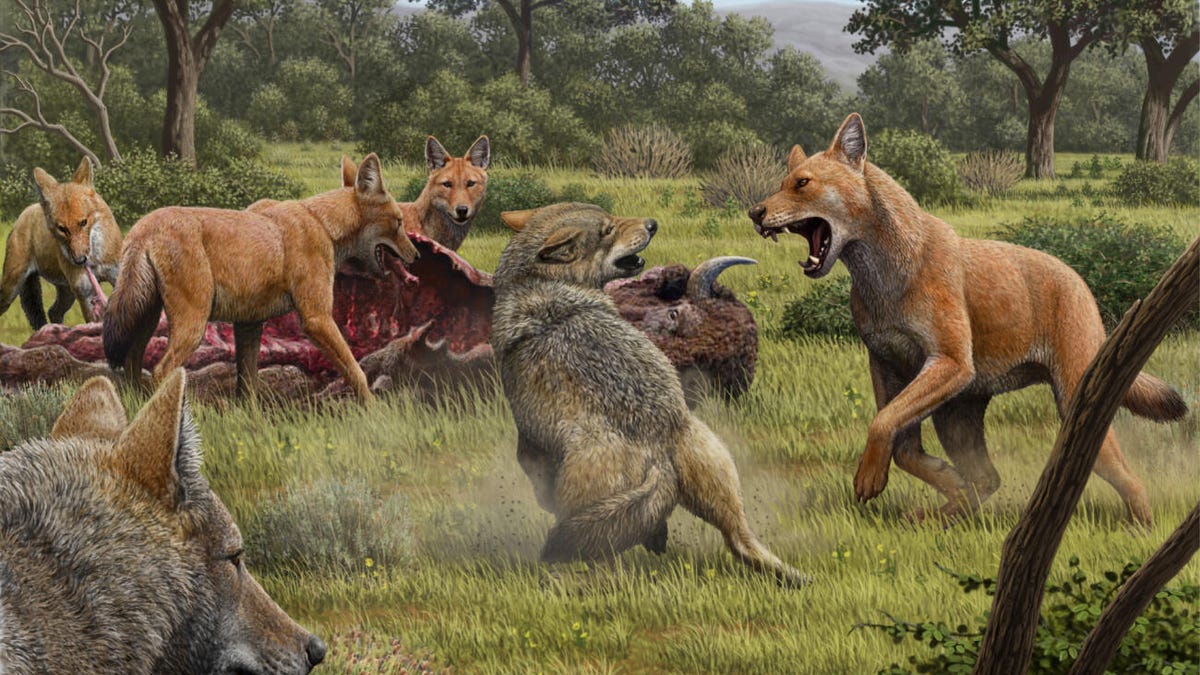Game of Thrones dire wolves were real. We now know why they went extinct
DNA evidence shows that the now famous -- and extinct -- dire wolf species couldn't mate with gray wolves.

In this illustration, a pack of dire wolves feed on a bison, while a pair of gray wolves approach in the hopes of scavenging.
Game of Thrones author George R.R. Martin didn't invent dire wolves, the animals famously given to Stark family children (even Jon Snow) as pets in the book and TV series. They're a real, but now extinct, canine species that lived from 125,000 years ago until around 9,500 years ago. A new study reveals more on why the creatures aren't around anymore: Dire wolves couldn't make little dire wolf litters with today's gray wolves, even if they wanted to.
"Despite anatomical similarities between gray wolves and dire wolves -- suggesting that they could perhaps be related in the same way as modern humans and Neanderthals -- our genetic results show these two species of wolf are much more like distant cousins, like humans and chimpanzees," said the University of Adelaide's Kieren Mitchell, co-author of the study published Wednesday in the journal Nature.
Gray wolves can and do interbreed with other similar animals, including African wolves, dogs, coyotes and jackals, but dire wolves were too genetically different to mate with the other groups. According to the study, dire wolves split off from these wolves lineages nearly 6 million years ago and were only a distant relative of today's wolves.
In a scene from HBO's Game of Thrones, Tormund Giantsbane and Jon Snow's dire wolf, Ghost, watch Jon ride away.
"While ancient humans and Neanderthals appear to have interbred, as do modern gray wolves and coyotes, our genetic data provided no evidence that dire wolves interbred with any living canine species," Mitchell said. "All our data point to the dire wolf being the last surviving member of an ancient lineage distinct from all living canines."
The research was led by Durham University in the UK, with help from scientists at the University of Oxford, Ludwig Maximilian University in Germany, the University of Adelaide and UCLA. The team sequenced the ancient DNA of five dire wolf sub-fossils from Wyoming, Idaho, Ohio, and Tennessee, dating back to over 50,000 years ago.
The study was the first time ancient DNA has been taken from dire wolves and it suggested that the species evolved solely in North America for millions of years, not migrating as other species do between North America and Eurasia. Because the wolves could not interbreed with other species, the researchers postulate some of the genetic traits that kept those species alive were not handed over to the ancient canines.
More than 4,000 dire wolves have been excavated from the La Brea Tar Pits in Los Angeles, the study notes, but scientists don't know much about the reasons why they disappeared. Gray wolves, also found in the pits, still exist today.

